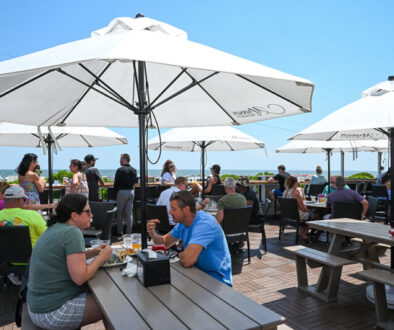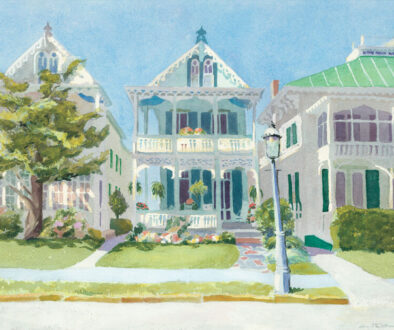Carnival Glass
Summer often reminds us of carefree days with fun houses, boardwalk games, prizes, and carnivals. Long ago, a fanciful novelty in luminescent glass became the coveted prize at these venues.
When Carnival Glass is held up to the light and rotated, a wave of colors and distortions appear like a funhouse mirror. Imagine staring at the surface of a bubble and seeing the oil-slick rainbow, giving the glass its uniqueness.
This art glass started in the early to late 1900s in Europe and the United States. Lighting in the home was still in its infancy as gas and kerosene fuels dominated. The complex glass reflected what little light there was in a dark room and gave the illusion that the piece was lit from within.


It wasn’t until the 1950s, after interest had waned decades earlier, that collectors, along with savvy dealers, named this unusual glass “Carnival Glass.” Different size vases, nut and candy dishes, goblets and more, were used as prizes at carnivals and festivals. Soon, everyone wanted to own a piece.
Originally, Tiffany and Steuben had produced unique art glass for their wealthy clients. Other companies followed suit, producing their own versions. Fenton, Imperial, Millersburg, Northwood, and U.S. Glass were the main manufacturers. The glass was mass-produced and considered “poor man’s Tiffany,” affordable for the not so wealthy. In 1908, Fenton Art Glass labeled their glass Iridill. But Iridill’s popularity faded and eventually became used for carnival prizes. Fenton stopped producing this glass shortly thereafter. The glass only made a resurgence in the late 21st century, ending in 2007, when the Fenton plant permanently closed.
Various items emerged over the years including figures—some famous, some not so famous—dishes lettered with embossed advertisements, motifs of birds, butterflies, fish, even landmark buildings, butter dishes, and more. Different vases could be produced from the same mold. For example, while the hot glass was still malleable, the rim of a piece could be folded inwards, another remained straight, and another was drawn outward.
The iridescent shine found in Carnival Glass is achieved by the use of metallic salts during the mold process. The color is not given to the overall finished product but by the “base” color used before the mineral salts are applied. To identify the base color, you need to examine an area that doesn’t contain iridescence. Often, this is found in an obscure place at the bottom.
Examining a 14” tall vase, I hold it towards the light and study the bottom of it—a dark blue color is noticeably apparent. This vase is in iridescent blues and gold with six flutes. Each flute is patterned with a peacock feather motif, which is highly unusual. It’s referred to as a Plume Panel Vase. Although there is no identifying factory logo, I believe it to be Fenton. Other popular vase types are in a rib pattern. Some have a knobby texture known as the tree trunk pattern.
In the case of creating a vase like this one, the glassblowers used the “Swung Glass Method.” When the glass is hot, it’s pressed into a mold and remains there until slightly cool to the touch. Then the glassblower picks the vase up by its neck and swings it in a pendulum motion. This allows the glass to stretch and twist into the desired shape. This technique created a unique and varied form of glass, literally “freezing”it in motion, making no two pieces alike. Then the glass is sprayed with liquid metallic salts to achieve the various distortions of color, creating a permanent iridescent finish. It dazzles the viewer as the piece is slowly turned, radiating a multitude of colors.


When searching for carnival glass, remember that it’s the color, along with condition, that will determine the value. Carnival Glass collectors have identified 60 colors, but the most common are yellow, blue, purple, and green. Red is the rarest color and commands premium prices. A deep cherry red example is highly sought after, although most pieces in this color are in the hands of collectors or museums.
Marigold, a yellow-orange color, was popular and is often found in antique shops, estate, and yard sales—if you’re lucky enough to find them. Three pieces I discovered at Out of the Past antiques in Cape May were marigold and reasonably priced. One lovely piece displayed opalescent blooms at the thicker parts of the dish making it a nice find. Most examples carry the color throughout the entire piece and don’t have a manufacturer’s mark. And some pieces are more reflective than others, making them even more collectible.
There have been highly desirable finds that even in 2018 were sold between $40,000 and $155,000. The items were Millersburg pieces: a pitcher in the morning glory pattern in amethyst and a “peoples” vase in blue. The prices even baffle me, but like most things in the antique world, rarity, color, and mint condition will only increase the value.
Pieces made before 1940 hold the most value but must be pristine—no chips, cracks, wear, or faded colors. Breakage over the last hundred years has helped to increase the value of the these. The older, the better because recent manufactured items can’t compare to hand-crafted art glass. Because of the amount of Carnival Glass produced until 2007, the value is also affected. And buyer beware: Carnival Glass has been made in the late 21st century, in countries like India, Sweden, Poland, and China. Don’t forget to look for rough mold lines along with color as a telltale sign of a fake.
Happy hunting!



